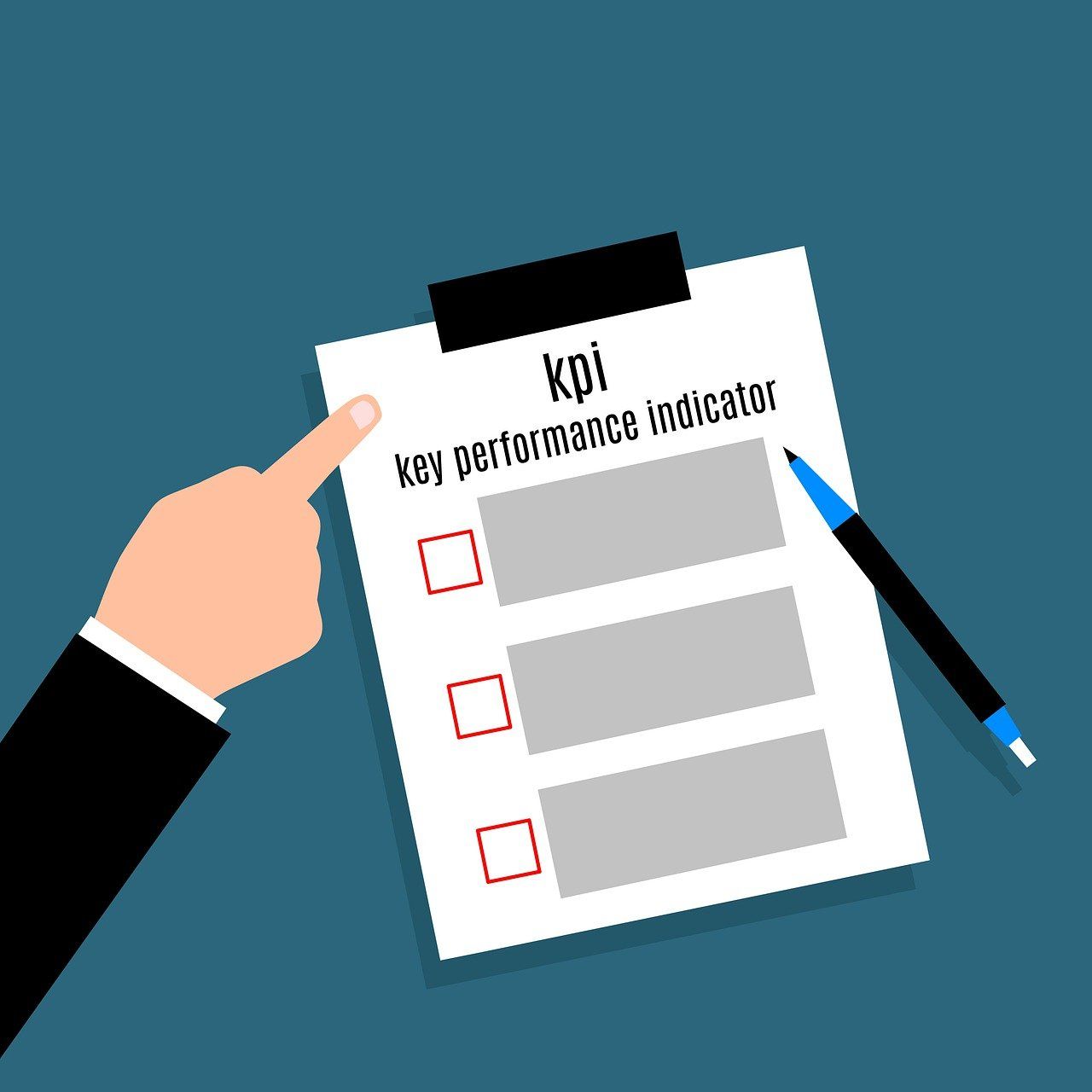Any business runs on ambition and sound practices. But how do you judge the health and direction of the company? The answer lies in KPIs (Key Performance Indicators)
In this article, we shall be visiting the following concepts
- What is a KPI, and what are its characteristics
- How to define KPIs for your own business
- Types of KPIs
- Examples of industry-specific KPIs
Let’s dive in.

What is a KPI?
KPI, or Key Performance Indicator, is a measurable and achievable metric that helps businesses track progress and measure effort towards a desired business objective.
The chances are that you are already using some KPIs to run your business. They might be called goals, targets, or benchmarks in your industry, but you sure are looking at them.
Inherently there are three dimensions to a Key Performance Indicator
1. A KPI is quantifiable – This translates into having a number ascribed to it
2. A KPI is measurable – It can be compared with past trends as well as future projections
3. A KPI is crucial – Inherently, they should be essential to the overall health of the business
Another existing framework for KPI is that it should be SMART.
Let's break SMART down to highlight the qualities
- Specific: The KPI you're looking at needs to be detailed enough that the information gathered will be relevant and provide information that you can act on. The broader the indicator, the harder it is to verify why you're succeeding or failing in that area.
- Measurable: The best KPIs are numeric or can be measured in a quantifiable way. You can determine a percentage or place a value that quickly shows performance that you can benchmark against past and anticipated numbers.
- Attainable: KPIs are not the place for pie in the sky goals. You want to make sure that you set your KPIs so that they are achievable but not so simple that you're not moving the needle at all.
- Realistic: Your KPIs should be a measurement that's realistic for where your company is and what you hope to achieve in the short term. You can move the goals as you complete them, but this isn't the place for your long-term vision.
- Timely: You need to determine the schedule for meeting KPI. For instance, managers can set employee KPI at the start of the year. Other indicators may need to be reviewed weekly or monthly.
How to define KPIs for your own business?
Not every company requires similar KPIs. A start up shall have a very different set of KPIs when compared to a well established company.
For example a start up shall be concerned about its profitability which then becomes an important KPI for it. However for a well established company, sales growth may be a more important KPI. Hence KPIs can vary from company to company.
However, the below steps can be followed to arrive at a KPI.
1. Define the objective – This means zeroing on the KPI that shall be evaluated and is relevant for business. Important to differentiate between a metric and a KPI.
Metrics are just a way of measuring things. KPIs are a method of monitoring the most critical aspects of your business in a way that helps you determine what actions to take. What’s more, KPIs are often created from two or more metrics.
For example, here are two metrics:
- Website traffic
- Number of sales
Now, the relationship between these two metrics is a popular KPI called “conversion rate.”
2. Outline the scope – What will the KPI help with? KPI shall be compared against which particular trends? Subsequently what would be the period of evaluation? Important to get clarity on these so that there is enough rigor in the process.
3. Project the findings – Having received the KPI, projecting it to key stakeholders is important. KPI reporting or KPI dashboard becomes important here.
What Are the Types of KPIs?
There are multiple types of KPIs and below is a summary list
- Long Term or Strategic KPIs: These KPIs are focused on long-term objectives derived from the organization's goals. They help identify if a strategy is working and if it is on target. The period involved here is long-term on intermediate.
- Short Term or Operational KPIs: These KPIs clearly articulate detailed and timely information that is used to make day-to-day decisions, or take corrective actions on performance or a process. These KPIs are usually complex as they use formulas with data from multiple sources.
- Lagging KPIs: Lagging KPIs are used to determine the result of past performance, such as production, volume, or a result. They are easy to measure as they are typically a simple value that is used to understand how well a process is performing. For example, the 'number of website visits' or 'sales this month' are lagging KPIs.
- Leading KPIs: Leading KPIs are used to predict or influence future performance. They are more difficult to set up as they rely more on external actions to impact outcomes, such as changes in process or investments in infrastructure. For example, “market share” as a marketing KPI is dependent on external factors such as category sales.
Examples of Industry-specific KPIs
E-commerce KPIs
1. Shopping cart abandonment rate
Cart abandonment is a term used in e-commerce to refer to visitors placing items in their shopping cart, but then leaving the site without completing the purchase.
The shopping cart abandonment rate is calculated by dividing the number of completed purchases by the number of shopping carts created.
2. Conversion rate
Conversion rate refers to the percentage of your visitors who take an action on your website. This action can be anything, such as signing up for an email newsletter or making a purchase.
To calculate your conversion rate, divide the number of conversions by the number of visitors to your store, and then multiply it by 100 to get the percentage.
3. Cost of customer acquisition
Customer acquisition cost – also referred to as CAC – is how much money it takes to “buy” a customer.
To calculate your customer acquisition cost, simply divide the total amount of money spent on marketing and sales by the total number of customers those activities delivered
4. Average order value
Average order value – also know as AOV – is an e-commerce metric that refers to the average amount of money spent by customers per order.
To calculate your average order value in a given time frame, take your total revenue and divide it by the total number of orders
5. Customer lifetime value
Customer lifetime value – often referred to as CLV, CLTV, or LTV – is the average amount of net profit that each customer is predicted to contribute to a business over the entire length of the relationship.
You need to have calculated three other averages from your metrics:
- Average order value
- Number of times a customer buys per year on average
- Average customer retention time in months or years
6. Return On Ad Spend (ROAS)
ROAS is the amount of money a business is getting back in revenue for every dollar you spend on advertising to drive new revenue.
It gets derived from revenue from advertising and the cost of advertising.
Retail Industry KPIs
1. Sales per square foot
This metric pertains to the number of sales generated per square footage of sales space in the store. This does not include fitting rooms or stockrooms.
2. Conversion Rate
The conversion rate is the proportion of store visits to the number of shoppers who made a purchase
3. Average Transaction Value
This metric gives a general idea of how much people are spending. A high dollar amount could mean that shoppers are purchasing your more expensive products or they’re buying larger quantities.
This metric tells you how much shoppers spend on your store on average. This can be derived at Total revenue by the number of transactions.
4. Stock turnover
Stock turnover is a critical metric for determining your optimal inventory levels. If your stock turnover is low, then it means you’re not selling out of inventory fast enough, and you risk carrying slow or dead stock. If it's high then it means that you need to maintain inventory.
Health Care Industry KPIs
- Average Patient Wait Time
The Average Patient Wait Time is a very useful KPI for measuring and tracking business objectives around patient satisfaction and capacity management. Patient wait time can be calculated by finding the average amount of time a patient must wait from the moment they walk into a hospital or healthcare clinic until the time they can be seen by a healthcare professional.
2. Bed Occupancy Rate
The bed occupancy rate measures the proportion of hospital beds in use at any one time. Bed occupancy is a good indication of a hospital's ability to provide safe and effective treatments to patients.
3. Average Hospital Stay
Just as the name implies, this KPI tracks the average length of time patients stay in the hospital.
4. Average Treatment Charge
The average treatment charge measures the amount of money that a hospital or healthcare facility charges each patient for its treatment.
Social Media Management KPIs
1. Reach
Total Reach: The metric Total reach shows you how many unique users in total have seen your content.
Total Impressions: Impressions consist of the number of times content from your page is displayed. Increasing impressions lead to a growing community as well as to more engagement.
2. Community growth
Fan Adds/New Followers/New Subscribers: This helps in measuring how many new followers or subscribers you’ve gained within a given period.
Page Likes/Total Followers/Total Subscribers: One should also track the total number of likes or followers you have.
3. Engagement
The engagement rate is one of the most important social media marketing KPIs, as it allows you to measure either how people engage with a particular post, or with your entire page. It shows actual connectivity and involvement of the community or brand followers.
4. Conversion
This is one of the most critical deliverables of social media if lead generation is an important objective.
Looking at this important KPI allows you to create a funnel that helps in future conversion as well.
Marketing KPIs
1. Revenue
How much revenue is getting generated after the marketing initiatives whether is offline or online.
2. Conversion Rate
The conversion rate is a percentage point that shows the number of conversions divided by the number of people who visited your website or used your product or service
3. Cost of Customer Acquisition
The cost of customer acquisition is the amount of money you spend to acquire a new customer.
4. Share of Voice
Amount of share the brand enjoys in any medium on the overall category
5. Market Share
Brand share as a percentage of overall sales in the category
SaaS KPIs
For any SaaS business, the most important KPIs are associated with customer acquisition, retention and revenue.
- Churn Rate
This is the measure of customers being lost every month.
2. MRR - Monthly Recurring Revenue
MRR measures the recurring revenue being generated by all active customers each month.
3. CAC - Customer Acquisition Cost
CAC measures the direct amount spend in acquiring a customer in a given period.
4. LTV - Life Time Value
LTV measures the total revenue generated by a customer for the business before they churn.
5. LTV to CAC Ratio
The LTV to CAC ratio indicates whether unit economics are indicating growth, stagnation or regression.
You can read our article on SaaS KPIs to learn more about these 5 important KPIs.
Key Takeaways
And it is a wrap. We covered KPIs in detail, and learnt about how to define KPIs and what are some important KPIs or metrics for different types of businesses.
- KPI needs to be SMART and should have high action ability
- KPI that gets chosen for your own business need to help the business to take important decisions forward and hence need to be more than a metric
- There are multiple types of KPIs for capturing the present as well as projecting future
- Different industries have their own respective KPIs which demonstrate the above properties.
Conclusion
As with any business process, KPIs also need timely scrutiny or maintenance to keep them performing at their best. They are not valuable on their own.
As Andrew Lang put it, “Most people use statistics the way a drunkard uses a lamppost – more for support than illumination.”
Setting regular review periods will keep them relevant and providing optimum benefit.
At Deskera, we want to ensure that small businesses continue to thrive while we provide them the best inputs using the latest technology and tools. Deskera helps you stay ahead of the curve by bring you important financial KPIs in real time. You can try Deskera for free and see it yourself.


